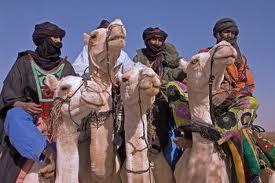Foreign affairsTuaregs set Sahara aflame, proclaim new country
Tuareg secessionist rebels have declared independence in an area larger than France in the northern two-thirds of Mali; the move, which has been condemned by the UN and the African Union, among others, has raised concerns about similar secessionist moves in neighboring Niger, where the Tueareg-populated areas contain large deposits of uranium and active uranium-mining operations; there are also fears about the relationship between an independent Tuareg government and al Qaeda-affiliated organizations in North Africa

Mounted Tuareg warriors // Source: alrakoba.net
Northern Tuareg secessionists in Mali, who have already seized two-thirds of that country — an area larger than France, but with a mostly-nomad Tuareg population of only two million — have proclaimed the Independent State of Azawad. Following a March 2012 military coup in Mali, lead by Captain Amadou Sanogo, which toppled Malian president Amadou Toure, the Rebel Tuareg National Movement for the Liberation of Azawad, which had already conquered more than half of Mali, declared independence (see Azawadi declaration of independence).
The Mali military coup threw Mali into further disarray and was internationally condemned. The Tuaregs, a Berber people now numbering some six million, inhabit the northern Sahara regions of Mail, as well as northern Niger and southern Algeria, have a long history of rebellions seeking their own country. Concerns have been raised that the Mali military unrest could create opportunities for al Qaeda-linked groups such as Al Qaeda of the Maghreb, and threaten the uranium mines of northern Niger.
The Tuareg are a Berber people originally from the Mediterranean coastal areas of Tunisia and Algeria. The eleventh century Islamic Arab invasions of North Africa by the Arab Bedouin tribes Beni Hilal and Beni Hassan from the Arabian peninsula and Egypt, forced many of the native Berbers, such as the Tuareg, to migrate south into the mountains and oasis areas of the Sahara.
The Tuareg became a highly romanticized people: their male warriors wore blue veils, carried antique firearms, and rode camels in daring long-range caravan raids across the Saharan wastes. Over time, the Tuaregs came to control the trans-Saharan trade routes across an area the size of Western Europe, until the nineteenth century.
The Tuareg women went veil-less and tended their children and slaves amid the date palms of the scattered Saharan Oasis. The Tuareg’s casual adherence to Islam, their longstanding rivalry with North Africa’s Bedouin Arabs, and their ancient written Berber language, Tamashak, distinguished them amongst North African peoples.
The image of the blue-veiled Tuareg desert warriors wandering the barren wastes of the vast Sahara has become iconic across much of the developed world. The Tuareg are featured in the 1924 novel Beau Geste and the 2005 Matthew McConaughey and Penelope Cruz film “Sahara.” In 2003 Volkswagen introduced its new SUV model, which it named the “Touareg.”
Colonized by the French, in the early 1900s, the Tuareg confederations were later divided among the post-colonial nations of Algeria, Mali, Libya, and Niger. The last fifty years have seen repeated Tuareg rebellions, principally in Niger and Mali, seeking
